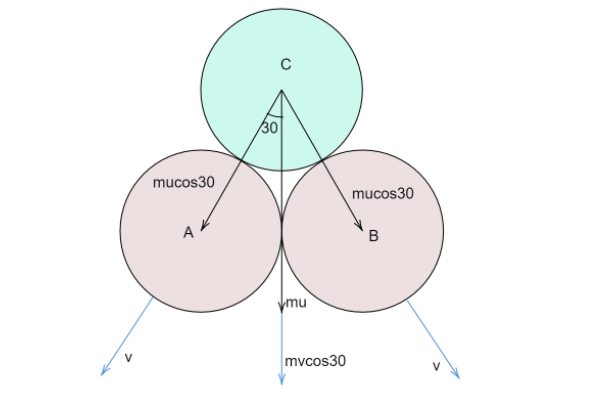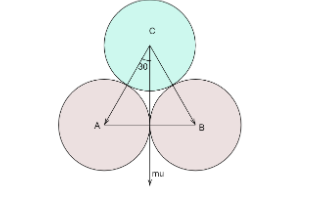
Two billiard balls of the same size and mass are in contact on a billiard table. A third ball of same size and mass strikes them symmetrically and remains at rest after the impact. Coefficient of restitution between the balls is-
(A) $\dfrac{1}{2}$
(B) $\dfrac{2}{3}$
(C) $\dfrac{2}{5}$
(D) $\dfrac{3}{4}$
Answer
159.3k+ views
Hint Coefficient of restitution is defined as the ratio of final relative velocity to the initial relative velocity between two objects. When the third ball strikes them symmetrically, it does so by making an angle of $30^\circ $from the normal line between the balls.
Complete Step by step solution
It is given that the two billiard balls are in contact, which means that the balls are either in rest or move with same velocity, let them be balls A and B.

Let the initial velocity of the third ball C be, $u$
Then the initial momentum of the ball C is given as,
$p = mu$
There is no external force acting in the system, the net change in momentum is zero, which means the total momentum is constant.
Let the final velocity of ball A (or B) be, $v$
Then, as per conservation of linear momentum along the vertical line we have-
${m_A}{u_A} + {m_B}{u_B} + {m_C}{u_C} = {m_A}{v_A} + {m_B}{v_B} + {m_C}{v_C}$
The mass of all balls is same,
The initial velocity of balls A and B is taken zero,
And final velocity of ball C is taken zero.
The ball C approaches the other balls at an angle of $30^\circ $from the vertical.
Therefore, velocity of approach$ = u\cos 30^\circ $
Along the vertical line, the momentum equation can be reduced to,
$mu + 0 + 0 = 0 + mv\cos \theta + mv\cos \theta $
$mu = 2mv\cos \theta $
From here,
$v = \dfrac{u}{{2\cos \theta }}$
\[v = \dfrac{u}{{{{2 \times \sqrt 3/2 }}}} = \dfrac{u}{{\sqrt 3 }}\]
After the collision, each ball starts moving along their line of impact with the velocity of separation and this velocity is equal to $v$.
The coefficient of restitution(e) is given by-
$e = \dfrac{{{v_{sep}}}}{{{v_{app}}}}$
Where${v_{sep}}$ is the velocity of separation and ${v_{app}}$ is the velocity of approach.
On putting the values,
$e = \dfrac{v}{{u\cos 30^\circ }}$
$e = \dfrac{{u/\sqrt 3 }}{{\dfrac{{u \times \sqrt 3 }}{2}}}$
$e = \dfrac{2}{{\sqrt 3 \times \sqrt 3 }} = \dfrac{2}{3}$
The coefficient of restitution is $\dfrac{2}{3}$.
Hence, the correct option is (B).
Note The angle $\theta $ is found using the shape of formation created by the three balls. Since they are of the same size, when the ball C hits symmetrically, the centers of all three balls form an equilateral triangle. The vertical line, along which the initial velocity of Ball C is, bisects one of the vertices of the triangle, thus this angle is equal to $30^\circ $.

Complete Step by step solution
It is given that the two billiard balls are in contact, which means that the balls are either in rest or move with same velocity, let them be balls A and B.

Let the initial velocity of the third ball C be, $u$
Then the initial momentum of the ball C is given as,
$p = mu$
There is no external force acting in the system, the net change in momentum is zero, which means the total momentum is constant.
Let the final velocity of ball A (or B) be, $v$
Then, as per conservation of linear momentum along the vertical line we have-
${m_A}{u_A} + {m_B}{u_B} + {m_C}{u_C} = {m_A}{v_A} + {m_B}{v_B} + {m_C}{v_C}$
The mass of all balls is same,
The initial velocity of balls A and B is taken zero,
And final velocity of ball C is taken zero.
The ball C approaches the other balls at an angle of $30^\circ $from the vertical.
Therefore, velocity of approach$ = u\cos 30^\circ $
Along the vertical line, the momentum equation can be reduced to,
$mu + 0 + 0 = 0 + mv\cos \theta + mv\cos \theta $
$mu = 2mv\cos \theta $
From here,
$v = \dfrac{u}{{2\cos \theta }}$
\[v = \dfrac{u}{{{{2 \times \sqrt 3/2 }}}} = \dfrac{u}{{\sqrt 3 }}\]
After the collision, each ball starts moving along their line of impact with the velocity of separation and this velocity is equal to $v$.
The coefficient of restitution(e) is given by-
$e = \dfrac{{{v_{sep}}}}{{{v_{app}}}}$
Where${v_{sep}}$ is the velocity of separation and ${v_{app}}$ is the velocity of approach.
On putting the values,
$e = \dfrac{v}{{u\cos 30^\circ }}$
$e = \dfrac{{u/\sqrt 3 }}{{\dfrac{{u \times \sqrt 3 }}{2}}}$
$e = \dfrac{2}{{\sqrt 3 \times \sqrt 3 }} = \dfrac{2}{3}$
The coefficient of restitution is $\dfrac{2}{3}$.
Hence, the correct option is (B).
Note The angle $\theta $ is found using the shape of formation created by the three balls. Since they are of the same size, when the ball C hits symmetrically, the centers of all three balls form an equilateral triangle. The vertical line, along which the initial velocity of Ball C is, bisects one of the vertices of the triangle, thus this angle is equal to $30^\circ $.

Recently Updated Pages
A steel rail of length 5m and area of cross section class 11 physics JEE_Main

At which height is gravity zero class 11 physics JEE_Main

A nucleus of mass m + Delta m is at rest and decays class 11 physics JEE_MAIN

A wave is travelling along a string At an instant the class 11 physics JEE_Main

The length of a conductor is halved its conductivity class 11 physics JEE_Main

Two billiard balls of the same size and mass are in class 11 physics JEE_Main

Trending doubts
JEE Main 2025 Session 2: Application Form (Out), Exam Dates (Released), Eligibility, & More

JEE Main 2025: Derivation of Equation of Trajectory in Physics

Electric Field Due to Uniformly Charged Ring for JEE Main 2025 - Formula and Derivation

Displacement-Time Graph and Velocity-Time Graph for JEE

Uniform Acceleration

Degree of Dissociation and Its Formula With Solved Example for JEE

Other Pages
JEE Advanced Marks vs Ranks 2025: Understanding Category-wise Qualifying Marks and Previous Year Cut-offs

JEE Advanced 2025: Dates, Registration, Syllabus, Eligibility Criteria and More

Units and Measurements Class 11 Notes: CBSE Physics Chapter 1

Motion in a Straight Line Class 11 Notes: CBSE Physics Chapter 2

NCERT Solutions for Class 11 Physics Chapter 1 Units and Measurements

NCERT Solutions for Class 11 Physics Chapter 2 Motion In A Straight Line




